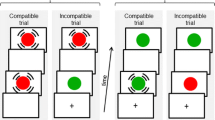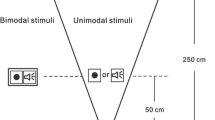Abstract
The present study investigated crossmodal spatial congruence effects in the cued modality-switching paradigm of Lukas, Philipp, and Koch (Psychol Res 74:255–267, 2010). Bimodal auditory and visual spatial-location stimuli were presented simultaneously, and participants responded with a left or right key press to the left or right location of the stimulus in the cued modality. Results replicated the asymmetric spatial congruence effects reported by Lukas et al. for a compatible mapping of stimulus locations to responses, with higher performance cost for spatially incongruent stimuli when the relevant modality was auditory and the irrelevant modality visual than when the relation was opposite. A similar result pattern was found when the stimulus–response mapping was incompatible and when the responses differed along an orthogonal vertical axis, consistent with the view that the visual dominance effect depends on correspondence between the auditory and visual stimulus locations. Blocking the relevant modality to remove uncertainty reduced but did not eliminate the visual dominance effect, even with brief stimulus durations. The findings provide broad support for crossmodal visual dominance, even when participants know to direct attention to the auditory modality.
Similar content being viewed by others
References
Colavita, F. B. (1974). Human sensory dominance. Perception & Psychophysics, 16, 409–412.
Colavita, F. B. (1982). Visual dominance and attention in space. Bulletin of the Psychonomic Society, 19, 261-262.
Egeth, H. E., & Sager, L. C. (1977). On the locus of visual dominance. Perception & Psychophysics, 22, 77–86.
Hedge, A., & Marsh, N. W. A. (1975). The effect of irrelevant spatial correspondences on two-choice response-time. Acta Psychologica, 39, 427–439.
Khine, S. Z. K., New, T. L., & Li, H. (2007). On timbre based perceptual feature for singer identification. Proceedings of the International Computer Music Association, 484–487.
Kornblum, S., Hasbroucq, T., & Osman, A. (1990). Dimensional overlap: Cognitive basis for stimulus–response compatibility—A model and taxonomy. Psychological Review, 97, 253–270.
Liefooghe, B., Wenke, D., & Houwer, J. D. (2012). Instruction-based task-rule congruency effects. Journal of Experimental Psychology: Learning, Memory, and Cognition, 38, 1325–1335.
Loy, D. G. (2006). Musimathics, volume 1: A guided tour of the mathematics of music. Cambridge, MA: MIT Press.
Lukas, S., Philipp, A. M., & Koch, I. (2010). Switching attention between modalities: Further evidence for visual dominance. Psychological Research, 74, 255–267.
Lukas, S., Philipp, A. M., & Koch, I. (2014). Crossmodal attention switching: Auditory dominance in temporal discrimination tasks. Acta Psychologica, 153, 139–146.
McGurk, H., & MacDonald, J. (1976). Hearing lips and seeing voices. Nature, 264, 746–748.
O’Connor, N., & Hermelin, B. (1972). Seeing and hearing and space and time. Perception & Psychophysics, 11, 46–48.
Posner, M. I., Nissen, M. J., & Klein, R. M. (1976). Visual dominance: An information-processing account of its origins and significance. Psychological Review, 83, 157–171.
Proctor, R. W., & Pick, D. F. (1998). Lateralized warning tones produce typical irrelevant-location effects on choice reactions. Psychonomic Bulletin and Review, 5, 124–129.
Proctor, R. W., & Pick, D. F. (2003). Display-control arrangement correspondence and logical recoding in the Hedge and Marsh reversal of the Simon effect. Acta Psychologica, 112, 259–278.
Ragot, R., Cave, C., & Fano, M. (1988). Reciprocal effects of visual and auditory stimuli in a spatial compatibility situation. Bulletin of the Psychonomic Society, 26, 350–352.
Simon, J. R., & Craft, J. L. (1970). Effects of an irrelevant auditory stimulus on visual choice reaction time. Journal of Experimental Psychology, 86, 272–274.
Sinnett, S., Spence, C., & Soto-Faraco, S. (2007). Visual dominance and attention: The Colavita effect revisited. Perception & Psychophysics, 69, 673–686.
Thurlow, W. R., & Jack, C. E. (1973). Certain determinants of the “ventriloquism effect”. Perceptual and Motor Skills, 36, 1171–1184.
Waszak, F., Hommel, B., & Allport, A. (2003). Task-switching and long-term priming: Role of episodic stimulus-task bindings in task-shift costs. Cognitive Psychology, 46, 361–413.
Welch, R. B., & Warren, D. H. (1980). Immediate perceptual response to intersensory discrepancy. Psychological Bulletin, 88, 638–667.
Wenke, D., Gaschler, R., & Nattkemper, D. (2007). Instruction-induced feature binding. Psychological Research, 71, 92–106.
Winckell, F. (1967). Music, sound and sensation: A modern exposition (T. Binkley, Trans.). New York: Dover.
Author information
Authors and Affiliations
Corresponding author
Ethics declarations
Conflict of interest
The authors declare that they have no conflict of interest.
Ethical approval
All procedures performed in studies involving human participants were in accordance with the ethical standards of the institutional and/or national research committee and with the 1964 Helsinki declaration and its later amendments or comparable ethical standards.
Informed consent
Informed consent was obtained from all individual participants included in the study.
Rights and permissions
About this article
Cite this article
Tomko, L., Proctor, R.W. Crossmodal spatial congruence effects: visual dominance in conditions of increased and reduced selection difficulty. Psychological Research 81, 1035–1050 (2017). https://doi.org/10.1007/s00426-016-0801-2
Received:
Accepted:
Published:
Issue Date:
DOI: https://doi.org/10.1007/s00426-016-0801-2








